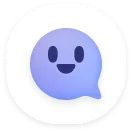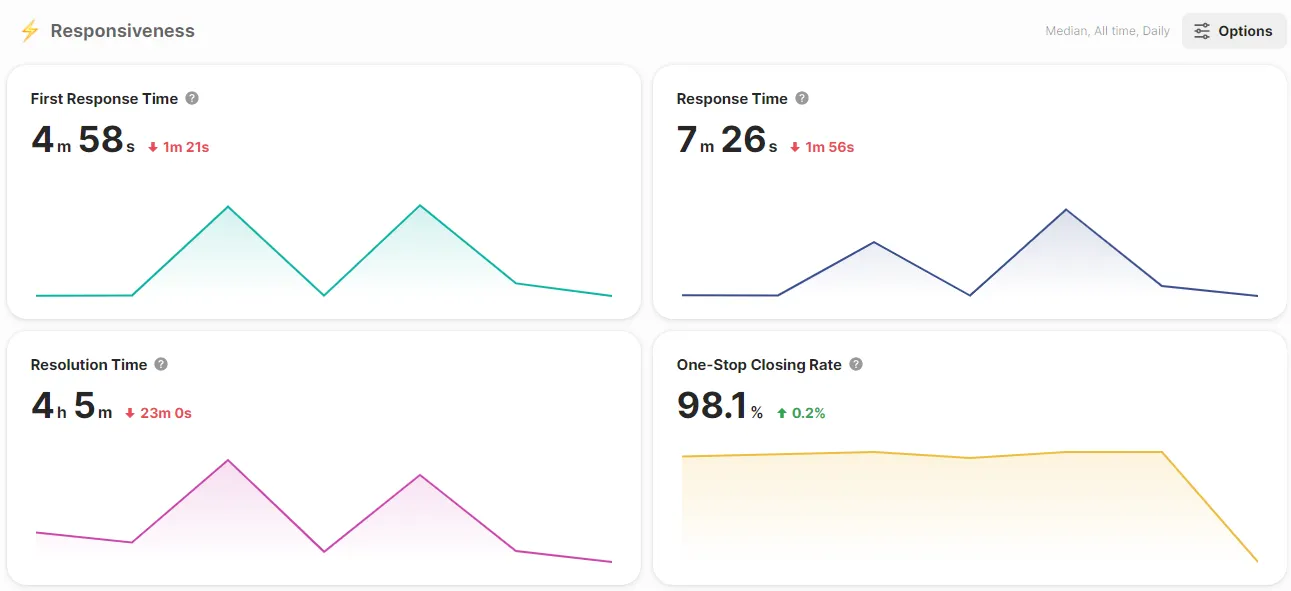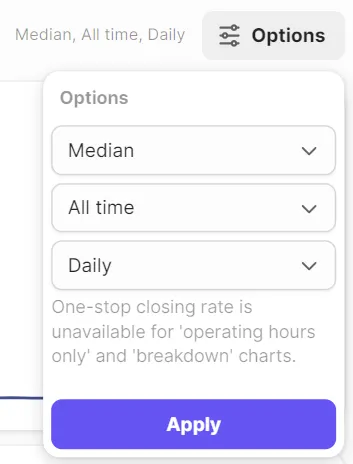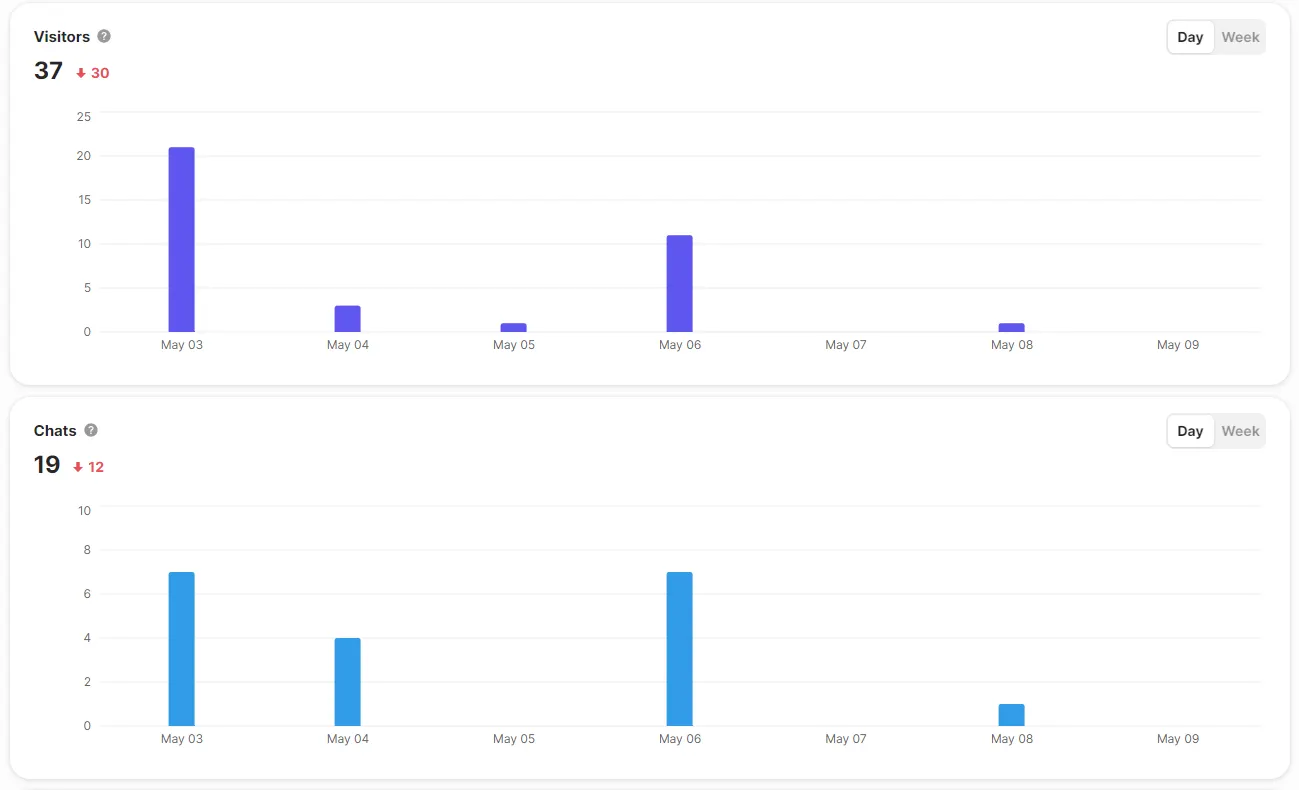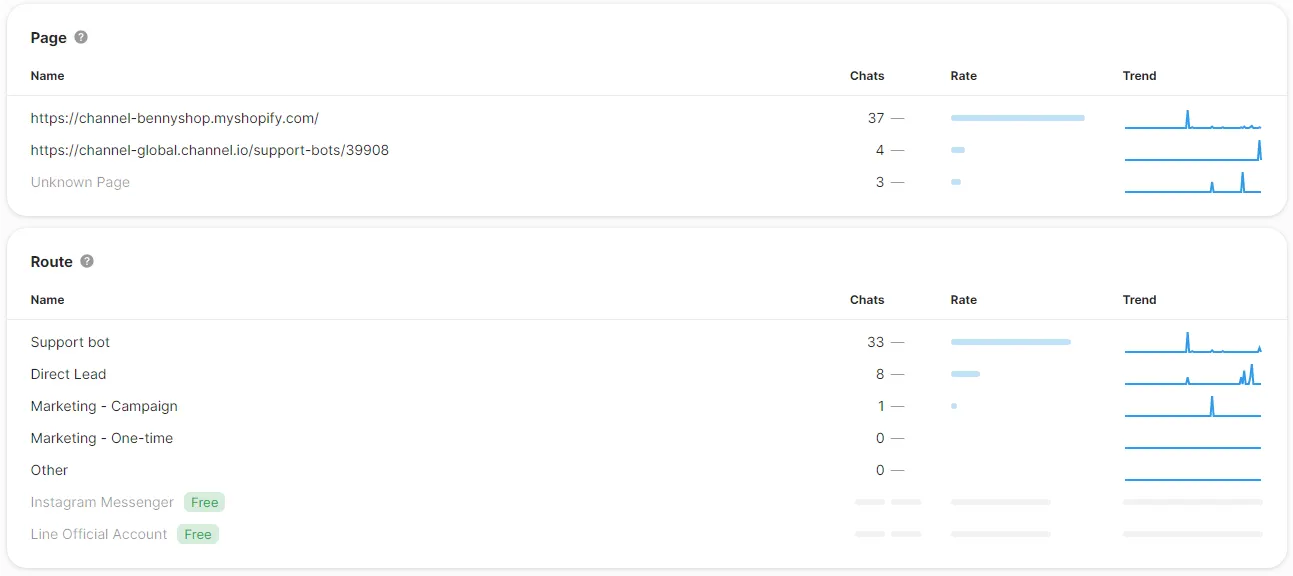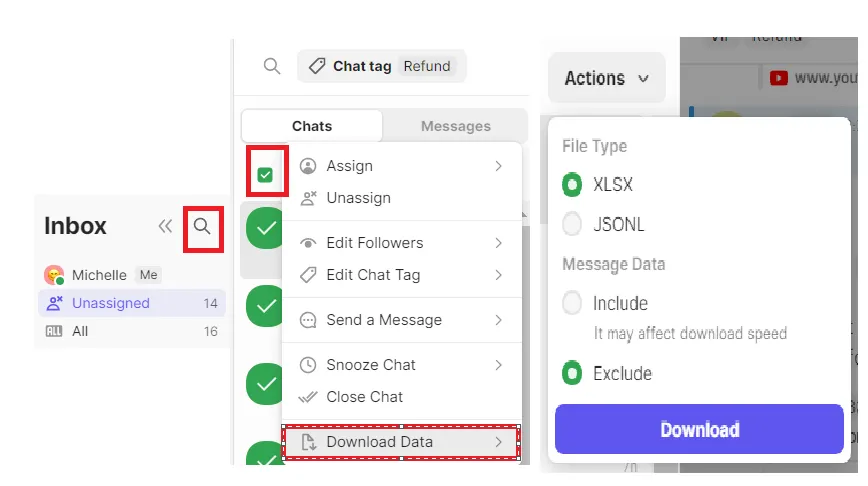Efficiency is the core of Customer service operations. Through chat analytics you can check a detailed and robust statistical record of your customer service. Look at detailed reports of current and past chats, the long term trends, and find what improvements can be made to your team’s strategy!
Explore the basis of chat statistics
Filters
Filter through specific metrics such as period, manager, follower, and tags. In addition , if you press the magnifying glass button you can get quick access to the chats which make up that dataset.
What is responsiveness?
You can look over the response time for every incoming inquiry, you can further inspect the data through setting filter conditions.
Next to each statistic category you can see the rate of change(ROC). It shows the change in the statistic relative to the preceding time period. If there is no data in the preceding period, then the ROC is set as -.
E.g.) If you are filtering your statistics for the month of April (01/04→ 30/04) then the ROC statistic will show you the change from the statistic for the 30 day period of March (01/03→30/03)
Understanding the graphs
•
First response time (WaitingTime/OperationWaitingTime)
This is the statistic which measures the period of time from user’s first message until the operator’s response.
This metric is still measured if the operator sent the first message. In such a case, it measures the customer’s first message and the operators follow up message. In other words, it measures the time from a customer’s first message until the operator’s response after such message
•
Equation: FirstRepliedAtAfterOpen - OpendedAt
◦
OperationWaitingTime = FirstRepliedAtAfterOpen (Operation time) - OpendedAt (Operation time)
E.g.)
•
The Customer sends their first message at 1:03, and after the chat is opened the operator responds with their first message at 1:10. Therefore, the First response time for this chat is 7 minutes
•
The Customer send their first message at 9:22, but then sends a second message at 9:25 and the operator responds at 9:30. Therefore the first response time is 8 minutes (30-22)
•
The Operator sends a message at first to the chat room at 11:00, but the customer doesn't respond until 11:30. Then at 11:32 the operator responds back. So, in this case the first responds time is 2 minutes.
•
Average Reply time (AvgReplyTime/OperationAvgReplyTime)
This metric measures the average reply time for chats for your team. It will measure the time between your customers first response, and your manager’s last message, and then normalize it over the entire length of the chat room. In layman’s terms, it is the average respon
•
Equation: AvgReplyTime = TotalReplyTime / ReplyCount
•
OperationAvgReplyTime = OperationTotalReplyTime / OperationReplyCount
•
Resolution Time (ResolutionTime/OperationResolutionTime)
Measure the time from opening a chat until time to close the same chat.
•
ResolutionTime = ClosedAt - OpenedAt
•
OperationResolutionTime = ClosedAt (During Business Hours)- OpenedAt (During Business Hours)
•
One-stop Closing Rate
One-Stop Closing Rate is a metric used to measure how many chats only have one operator assigned as a manager. Even if the person in charge of the chat switches from A→B→A it is still considered one-stop closing because the same operator opened and closed the chat.
All of these statistics, except for first response time, use data from closed chat only. First response time uses Opened, snoozed, and closed chats as data.
View Options
•
Summary statistics: Median|Average
•
Time: All | Operating Hours only
•
Graph View: Timeseries | Distribution
ATTENTION! What’s Operating hours?
Channel.io gives you the ability to look at a breakdown of your statistics but only for your operating hours, being able to increase in-hour efficiency.
Operating hours are set hors in the day which your customer service is actively seeking inquiries. As such, the operating hours statistic allows you to parse the data only occurring when your team is present.
E.g.)
•
If you have your office hours set from 9am - 12pm, and the 1pm - 6pm :
◦
If a new chat comes in at 10am and a manager responds at 11am → this interaction will count towards your analytics
◦
If a new chat comes in a t 11am but a manager responds at 12:30pm → this will not count towards operating hours statistic
◦
If a new chat comes in at 8am but a manager responds at 10am → This interaction will likewise not count towards Operating hours statistics.
◦
If a chat comes in at 11am but a manager responds at 3pm → This counts towards the operating hours statistic
◦
Finally, if a chat comes in at 3pm but ends at 11am the next day → Does not count towards statistics
If your operating hours are changed while checking statistics, the operating hours will be applied to the data and the analytics may change depending on the operating hours change.
E.g.)
•
Let’s consider the case of operating hours for the month of June were 9am - 6pm for the first ten days of the month, then for the remaining twenty days changed to 10am - 5pm.
◦
On June 9th, a new user chat is opened at 9:30am and on the same day a manager responds at 5:30pm → Counts toward operating hours statistic
◦
On June 12th, a new user chat is opened at 9:30am and a manager responds at 5:30pm → It will not count towards statistics because the operating hours changed.
What’s inflow?
Inflow is a metric measuring total number of new chats, closed or opened chats, visitors, tags, pages, and other important filter metrics.
1) Check the total number of visitors and consultations within a given period
Visitors
•
This metric is the total number of Unique Visitors (UV) who visited the homepage or app who also opened your Channel lounge.
•
If the same customer visits multiple times a day then they will only count as one UV.
•
Except for Page Visitors, inquiries received from external messaging inquiries (Instagram) are also counted as one visitor.
Chats
•
This shows the total number of chats in a given period.
•
If a customer starts a conversation again in a closed chatroom, the conversation will be counted as a new chat with a different start date.
•
If the same customer opens multiple chatrooms each chatroom counts as separate chats.
2) Check the distribution of opened/closed chats that occurred over a set period of time and date
Opened
•
Sum of all new chats during the predetermined period of time
Closed
•
Sum of all closed chats during the predetermined set of time
The number of chats is also color coded, with the darkness of color shade implying a large number of chats.
3) Parse your chat inflow by tags, pages, and route
Chat Tags
•
Under the Chat Tags statistic, you can measure which tags are inquiring and opening chats and their ratio compared to other tags.
•
You can also breakdown certain tags into their subtags (such as if you had a “US” tag and then multiple subtags of “northeast, southeast, midwest, south, west, and northwest” for each region).
•
Chats without any tags also are included in this statistic.
Page
•
You can check from which pages on your website do chats come. For example, if someone opens the chat on the homepage it will count towards a homepage chat. Even if a customer moves to a different page and reopens their chat window, it will still count towards the original page.
•
There is no page information provided if the chat is opened via:
◦
Support bot that is attached to a marketing campaign
◦
External messengers(Instagram, Line, etc.)
Routes
•
During the set period, this statistic breaks down from which method did chats come from. For example, it breaks it down from support bots, marketing campaigns, external messengers.
•
If multiple campaigns, support bots, or on-time marketing paths are running concurrently, they will be aggregated into general categories of “support bot, marketing -campaign, or marketing-one times”
•
If an operator first starts a chat through opening a new user chat, or through a plug-in link, it will be shown as “other”.
Trend
•
This shows the trends of each category over a selected period of time.
What is performance?
Performance is a leaderboard for your team. It allocates a score to each operator based on a number of factors such as number of chats assigned, One-Stop Closing Rate, First Response Time, and Resolution Time. Moreover, you can check the processing status of all the assigned chats to an operator (opened, snoozed, closed).
Operator Leaderboard
•
The leaderboard is a calculated score of multiple operator specific variables. The leaderboard score is based upon how efficiently each operator handled all of their chats, such as first response time, one-stop closing rate, and resolution time. As number of assigned chats go up, the more that operator’s score has weight on the leaderboard.
•
The leaderboard shows operators who have had at least one chat during the selected time period.
Chat Status
•
You can also parse the data into business hours, and also summary statistics such as average score and median score.
•
The graph shows the number of new chats over the selected time period (horizontal axis) whereas the vertical axis shows number of chats. Color represents the status of the chats.
•
If all open chats are closed the day previous, and there are no new chats incoming, then the graph will show zero for your current day.
•
You can monitor the trends and status of your chats, and you can make sure that no chats are left to fall between the cracks.
Download Chat Data
Do you want to do your own analysis of the data? On the dashboard you can easily download the data which makes up our analytics page. You can download the data wither as an Excel (XLSX) file or a JSONL file.
- You can download up to 10,000 data points per files
- These downloads are only available to those managers with “owner privileges”
- When downloading the data you need to set a password and write a purpose for the download.
- Only English language is supported on the files
- If you lose the password, the file cannot be recovered, you have to redownload the file
Where can I get the data from?
•
Go to [Operations]→ [Analytics]
1.
After filtering and selecting the desired conditions, select the download button
2.
Select file type, and message data
3.
Download
4.
If there is a lot of data, it may take a few minutes
•
Download User Chat by Search
1.
Under the userchat tab, click the magnifying glass
2.
Set the search conditions accordingly
3.
After selecting your desired conditions, go to → actions → Download data
You can only download up to 200 chats at one time
Description of chat metric names
•
Data worksheet tab
Tab value | Description |
UserChat data | Data from the chat including information and time data |
User data | Customer data |
SupportBot data | Data received from the support bot |
Marketing data | Data from chats opened through Marketing campaigns |
Manager data | Operator Data |
Bot data | Data from the Channel bot |
UserChatTag data | Tags related to chat |
Message data | Contents of the uerchat |
•
User chat data sheet
Data Value | Description | Remark |
id | User chat id | On the Message data you can reference the origin Userchat |
userId | Customer ID | |
name | Customer Name | |
description | Chat Description | |
state | Userchat Status | Opened / Snoozed/ Closed |
contactMediumType | Type of messenger (external) | appInstagramMessenger : Instagram messenger |
marketingId | Marketing Message ID | You can check the specific marketing message on the Marketing data Sheet |
marketingType | Marketing message type | - Onetime message : oneTimeMsg
- Campaign : campaign |
supportBotId | Supportbot ID | You can check the SupportBot data on the supportbot data sheet |
managerIds | Follower ID | You can check the followers on the Manager data Sheet |
assigneeId | Assignee ID | You can check the assignee data on the Manager data sheet |
tags | Chat Tags | |
firstOpenedAt | UserChat first opened time | This variable shows the time at which the customer first opened their UserChat |
openedAt | UserChat opened time
| - Time for New user chat created
- Time for reopened user chat after closed and snoozed status |
firstRepliedAtAfterOpen | Time when manager replied after Userchat was opened | - If the chat was opened again it changes |
createdAt | Time from first opening the Channel lounge to starting a chat | Button press time |
waitingTime | First response time: the time from when the customer first sends a message until a manager responds | - If a new chat is opened it remains the same |
avgReplyTime | Average response time | -This is the average of total reply time to the total number of replies in said chats (totalReplyTime/replyCount)
- is the chat is reopened it doesn’t change |
totalReplyTime | Total Reply Time | - This is the total amount of time it took for the manager to reply
- If a new chat is opened it does not change |
replyCount | Total number of manager’s responses | - If a new chat is opened it does not change |
resolutionTime | How long did was the UserChat from opened to closed status | -(closedAt - openedAt)
- If a new chat is opened it does not change |
operationWaitingTime | Waiting time during Operation hours | -If a new chat is opened it does not change |
operationAvgReplyTime | Average reply time during Operation hours | - If a new chat is opened it does not change |
operationTotalReplyTime | Total reply time for during Operation | - If a new chat is opened it does not change |
operationReplyCount | Total reply count during Operation hours | - If a new chat is opened it does not change |
operationResolutionTime | Resolution time of chats only during opersting hours | - If a new chat is opened it does not change |
closedAt | User chat closing time | - If a new chat is opened it does not change |
•
Support Bot data Sheet
Data value | Description | Remark |
id | Supportbot ID | |
revisionId | Support bot moderation ID | |
sectionPath | Record of the support bot path section that the customer chose on the edited version |
•
Manager Data Sheet
Data Value | Description | Remark |
id | Manager ID | |
channelId | Manager assigned channel ID | |
accountId | Channel.io account ID | |
username | Other mentioned manager ID | @ mentions |
name | Name presented to the customer | |
email | Email | |
mobileNumber | Phone number | |
role | Manager permissions | - Owner
- Member |
removed | Manager removed status | |
createdAt | Date manager joined Channel | |
defaultGroupWatch | Group message notification settings | - All activity : all
- Important only : info
- Nothing : none
* Based on time the data was downlowded |
defaultDirectChatWatch | DM alert settings | - All activity : all
- Important only : info
- Nothing : none
* Based on time the data was downlowded |
defaultUserChatWatch | User Chat notification settings | - All activity : all
- Important only : info
- Nothing : none
* Based on time the data was downlowded |
operator | Operator mode settings | * Based on time the data was downlowded |
operatorEmailReminder | Operator response email settings when operator mode is on | * Based on time the data was downlowded |
•
Bot data sheet
Data Value | Description | Remark |
id | Bot profile ID | |
channelId | Channel ID | |
name | Bot profile ID | |
createdAt | Bot profile creation date |
•
UserChatTag data sheet
Data value | Description | Remark |
id | Chat tag ID | |
channelId | Channel ID | |
name | Chat tag name | |
description | Chat tag description | |
followerIds | Manager assigned chat tag ID | |
createdAt | Assigned chat tag date |
•
Message data sheet
Data value | Description | Remark |
ChatId | Userchat ID | |
PersonType | Message sender information | -bot : all response messages
- manager
- user |
PersonId | Message sender ID | supportbot : bot ID
- manager : manager ID
- customer : customer ID |
CreatedAt | Message creation time | |
PlainText | Message content |
FAQ
Can you search only the chats which have all searched tags?
Can you see the pending chats in statistics?
There’s no chat data in Analytics
